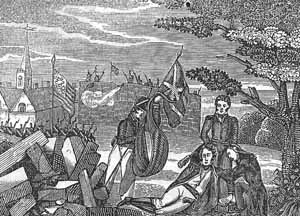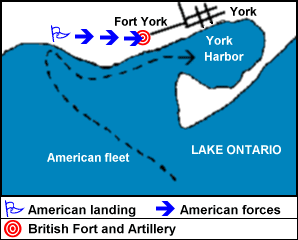War of 1812 Battles |
Colonial Wars |
American Wars |
Battle of York
April 27, 1813, York, Upper Canada
Books on The Battle of York are available from Amazon.com
 |
|||||||||||||||||||||
|
BACKGROUND - In the winter of 1813, American Secretary of War John Armstrong's strategy was simple: secretly mass an army at Sackett's Harbour before spring break-up. Once Lake Ontario was open to navigation, Commodore Isaac Chauncey's ships would ferry the troops across Lake Ontario to Kingston, which they should capture easily enough, given that it is known to be but lightly defended. Furthermore, once Kingston was in American control, Upper Canada should fall soon after. From Kingston, it was but an easy sail down the St. Lawrence River and the capture of Montreal, which would be difficult to defend. From Montreal, Quebec City was not very far away. On paper, at least, it seemed like a perfectly good plan.
But, as Armstrong was about to learn, in the real world, nothing happened as it does on paper.
The British found out about the American intentions and rushed in reinforcements on a winter snowshoeing journey of epic proportions, all the way from Fredericton, New Brunswick, to Kingston, Upper Canada. Chauncey and American army commander, Gen. Henry Dearborn, heard rumours of fresh British troops that had arrived at Kingston. The American army at Sackett's Harbour still greatly outnumbered the British defenders of Kinston, but in the American commanders' overheated imagination, it was the other way around. It is the American troops that was now outnumbered.
Why risk defeat at Kingston when attacking York, the Upper Canadian capital, could serve just as well? Besides, the British frigates HMS Isaac Brock and HMS Duke of Gloucester were still under construction at York. The balance of naval power on Lake Ontario was so precarious that the loss of 2 ships could have dealt the British a blow from which they might never had recovered. Somehow, Chauncey and Dearborn managed to convince Armstrong that the taking of York would have been just as effective against the British as the taking of Kingston could have been.

In fact, what they proposed amounted to attempting to fell a tree by chopping off one of its limbs rather than its trunk.
BRITISH at York -In the last days of April 1813, the American fleet was spotted making for York. Unfortunately, British Gen. Roger Hale Sheaffe, the victor at Queenston Heights, was not sure exactly where the American fleet would land. He split his little band of 300 regulars to post a detachment east of the village in case that would have proved the intended landing site. The rest of the regulars and perhaps 100 native warriors, he kept on standby at the garrison barracks near Government House. He then called out the militia.
On the morning of April 27, the American warships came into the harbor, sailed past the village, and anchored a couple of miles west of Government House. Sheaffe promptly dispatched the warriors, a company of Glengarry Highlanders, and a company of British grenadiers to try and stop the Americans before they could establish a beachhead. The York Volunteers were sent out to protect the regulars' flank and act as guides. Unfortunately, under their guidance, everybody became temporarily lost in the woods and by the time everybody finally reached the landing point, the Americans' first wave was already ashore and their riflemen were firing on the late arriving British and Canadians.
The best the regulars and Glengarries could do was fight a delaying action along the lake road against the American troops. The York Volunteers rapidly lost heart and all but vanished, along with the warriors who seemed to have melted into the woods. The American ships, meanwhile, were pouring a deadly barrage of grapeshot on the remaining British defenders.
Sheaffe realised he could not possibly have stopped the Americans, so he resolved to prevent them from seizing the HMS Isaac Brock, the frigate that was still under construction in the harbor, and the several hundred barrels of gunpowder in the garrison's main magazine, before retreating with his regulars to fight another day. Luckily, the HMS Duke of Gloucester, the other warship until recently also under construction here, sailed away only days before.
By the time the magazine exploded in a deafening roar, the HMS Isaac Brock was on fire and Sheaffe and his men were marching away at the far end of town. This left the 2 ranking militia commanders and their self-appointed "advisor," the Reverend John Strachan, to negotiate the terms of the surrender of the little capital.
AMERICANS at York - Maj. Gen. Henry Dearborn was grossly overweight and in no condition to lead his 1,700 men in the rough and tumble of combat. As the Americans prepared to attack, he placed Brig. Gen. Zebulon Pike in charge of the actual landing. Pike was among the first to come ashore.
The Americans were temporarily checked at the water's edge by the defending British until several shallow-draft American schooners sailed close enough to spray the British defenders with a barrage of grape and canister shot, inflicting terrible damage, and forced them to retreat back into the woods.
Pike and his men now advanced steadily towards the town, easily turning aside what little opposition the British had to offer. They were within a couple of hundred yards of the British blockhouse when Pike stoped to regroup his men before ordering the final assault.
Suddenly, the main powder magazine exploded in a blinding white flash, and sent tons of earth, rocks, broken timbers and assorted debris flying in every direction for more than a thousand yards. This explosion killed and maimed over 200 Americans. Pike himself was among the dying. He lived long enough to learn that although he succeeded in capturing York, it was a hollow victory. He had not only failed to seize the 2 British warships he came for, but the British regular troops he hoped to capture had eluded him as well.
After the departure of the British regulars, the Americans had not met any further resistance. At first, the occupation was orderly enough, but it quickly degenerated. The American troops were in the mood to avenge their country's previous losses. Private property was vandalised and looted, public buildings were destroyed and burned, and some private homes were torched as well. Dearborn was either unwilling or unable to stop his soldiers, though he deplored the worst of their actions in his correspondence. The Americans also seized the public stores destined for the Detroit frontier. They captured all the armament and equipment for the British Lake Erie fleet, including the fittings for Robert Barclay's newest ship down to its guns and ammunition.
As he sailed away on the first week of May, Dearborn wrote that, "We may consider the upper province as conquered."
THE BATTLE - The Americans planned on sailing from Sackett's Harbor across Lake Ontario to Kingston, but the British learned of the plan and sent reinforcements from New Brunswick. Although Kingston was more important from a military perspective, Commodore Isaac Chauncey and Gen. Henry Dearborn planned instead to sail to York.
British Gen. Roger Sheaffe saw the Americans coming, but was unsure of their landing spot; the fleet landed west of York on April 27. Unfortunately Sheaffe's troops did not arrive at the landing site before the approximately 2000 American troops had already come ashore. Dearborn placed Brig. Gen. Zebulon Pike in charge of the landing.
There had been some construction of the defenses at Fort York, but they were not far advanced. Three artillery batteries were set up along shore, but their heaviest guns were old and in poor condition. A stone powder magazine stood near the shoreline, and a few sketchy earthworks around it outlined the fort that was not yet completed.
The British counter attack, as a result of confusion on the part of the defenders, was made by only one company, the grenadiers of the King's Regiment, a picked company of one of the best British regiments. Their bayonet charge reached the beach; one American officer stepping from a boat was bayoneted in the shoulder. But it was 1 company against 4, with more Americans landing; the grenadiers, their company commander dead and many others dead or wounded were forced to retreat toward the town. Shaeffe had lost control of his command; 3 other companies arrived piece meal on the battlefield and were defeated one at a time.
The American force advanced along the beach with the support of naval gunfire from Chauncey's ships. Pike's field guns were landed and opened fire on the British positions. The local militia began to fade away from the defensive works. Sheaffe decided to withdraw his regulars. Leaving the flag flying over the fort, he marched his men away toward Kingston, advising the militia commanders to make contact with the Americans and get the best terms for surrender they could. He blew up the hundreds of barrels of gunpowder in the fort and set fire to HMS Isaac Brock, which was being constructed in the harbour. Another frigate, HMS Duke of Gloucester, was completed and sailed away from York days before the battle. Sheaffe then retreated, leaving the York militia to surrender.
By then the Americans were at the edge of the fort. Because it's flag was still flying they thought it was still garrisoned- which of coarse was Shaeffe's reason for leaving the flag there. General Pike was questioning a captured British sergeant when the stone magazine blew up. One witness said that the building rose slowly, assuming the shape of a vast balloon; then out of the balloon-shaped cloud huge stones and wooden beams began to rain down on the nearby Americans. Pike's back and chest were crushed, 28 of his men were killed outright, and over 200 were wounded.
The explosion mortally wounded General Pike. Pike was carried out to Chauncey's flagship, the new U.S.S. Madison, where he died. Dearborn landed and took personal command ashore.
The Americans pillaged and burned York, and captured supplies meant for use on Lake Erie and the Detroit frontier. American troops, seeking redress for past losses in the province, looted and vandalized homes and burned public buildings. Dearborn deplored the worst of the atrocities in his letters, but he was nonetheless unable or unwilling to rein in his soldiers.
He declared the province conquered, but his superiors criticized his failure to capture the frigate Isaac Brock. Both the American and British generals soon lost their commands. Although the captured supplies allowed for the success at the Battle of Lake Erie later in 1813, the attack also helped provoke the burning of Washington, D.C. in 1814. The United States, in failing to attack and take Kingston, never gained full control over Upper Canada; in fact, the Americans only held York for 5 days before abandoning it.

